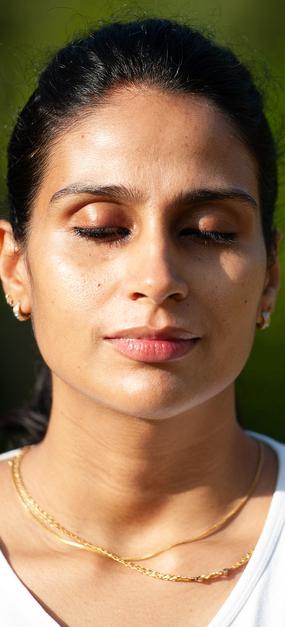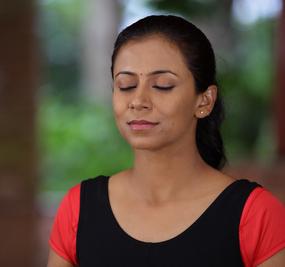Learning that you are pregnant is a life-changing event. It’s easy to get caught up in the excitement, but remember that health and wellness should be a top priority for expecting mothers. Your body is carrying and sustaining new life, and yoga is a wonderful way to keep yourself strong, serene, and healthy through all of the changes in the months to come. Yoga is incredibly beneficial during pregnancy, and this article aims to guide you through how specific yoga asanas can work wonders on how you function and how you feel in your first trimester. Varying widely in application and style, these postures gently stretch and explore all parts of your body and are an easyway to keep active and supple.
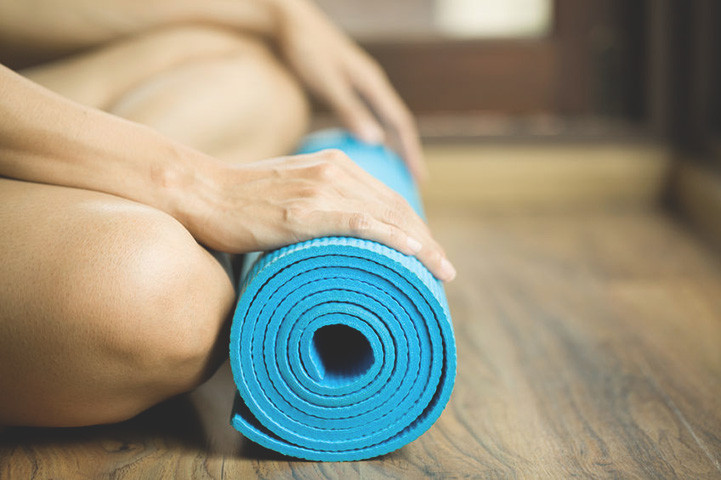
When to start Pregnancy Yoga
The first three months of pregnancy are a time of major changes in your body. Long before any outward manifestation begins to get in the way of doing poses, things feel different on the inside. This is the challenge of first trimester yoga, and also why yoga is so useful during this delicate phase of your life. The core of any yoga practice is listening to your body. You may think you know yourself and what your body can do, but on any given day you have to really tune in and respect the cues your body gives you. Taking the attitude that your body knows best and will guide you is also a good way to prepare for childbirth.
6 Yoga Tips for the First Trimester
- Learn under a qualified teacher. If you have never practiced yoga or have practiced very little before your pregnancy, you should practice only prenatal yoga while pregnant. It is recommended that you learn these asanas under expert guidance, rather than from pregnancy yoga videos.
- Continue with your practice throughout your pregnancy. If you already had a strong yoga practice before your pregnancy, you may be able to continue a fairly vigorous practice — with modifications — after your first trimester.
- Be gentle with your body. During the first trimester, both beginning and experienced yogis should only do a gentle practice, as the fetus is still implanting and the risk of miscarriage is at its highest. Practice basic poses with a few modifications. Build strength and flexibility with familiar poses, and make use of props in case you feel unbalanced or tired.
- Adjust your practice to accommodate your baby. Avoid inversions, closed twists, and backbends. These might compress the uterus or overstretch the abdominal muscles.
- Relax into mindfulness. Allot sufficient time for a long relaxation at the end of class or practice. This is a perfect time for you to practice focused breathing and meditation to be in the present moment.
- Trust in yourself. Remember, being pregnant does not mean you are sick or injured. Use your yoga practice to discover the strength and power in your body. While you need to modify some poses, you are still a strong, capable woman. Do the practice in a way that feels good to you. You are the only one who really can feel what is going on in your body, and you need to learn to trust your own instincts. With a little courage and practice, yoga will become an amazing tool for your birthing experience.
Yoga poses for the first trimester (0 to 12 weeks)
1. Kantha and Skandha Sanchalana
Roll your head back and forth, right and left, and in circles clockwise and counterclockwise along with slow gentle breaths. Similarly, rotate your shoulder blades back and forth, up and down, clockwise and counterclockwise. Do each movement 3-5 times.
Benefits
Do this with soft and easy breaths to releases tension from head, neck and shoulder area.
2. Ardha Baddha Konasana
Sit with your legs outstretched. Fold your right leg and place your right foot as far up on the left thigh as possible. Place your right hand on top of your folded right knee. Hold the toes of your right foot with your left hand. While breathing out, gently move your right knee up towards your chest. Breathing in, gently push your knee down towards the floor. Make sure that you are keeping your torso straight. Repeat with your left leg. Slowly practice about 10 up and down movements with each leg.
3. Baddha Konasana
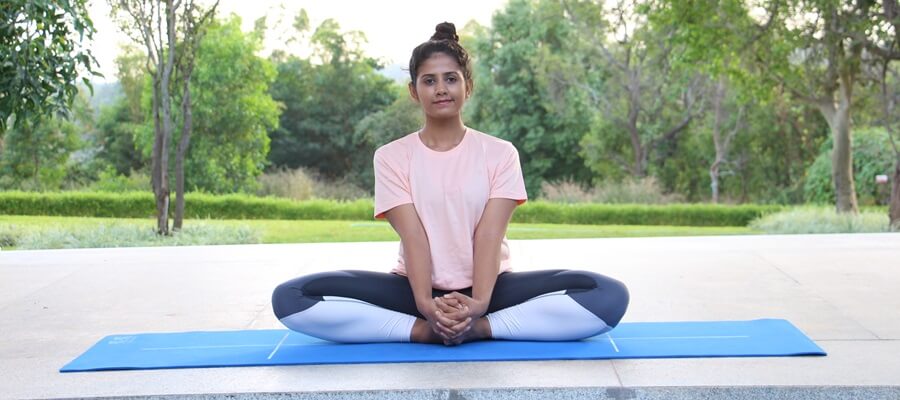
Sit with your legs outstretched. Bend your knees and bring the soles of the feet together, keeping the heels as close to the body as possible. Fully relax your inner thighs. Hold your feet with both hands. Gently bounce your knees up and down, using the elbows as levers to press the legs down. Do not use any force. Repeat up to 20-30 times. Straighten your legs and relax.
Learn more about Badha konasana.
Benefits
The half and full butterfly poses are excellent for loosening up the hip joint, and can increase blood circulation to the pelvic floor and help a woman get used to the feeling of opening up. They also help relieve tension and tiredness from inner thigh muscles and legs.
4. Marjariasana
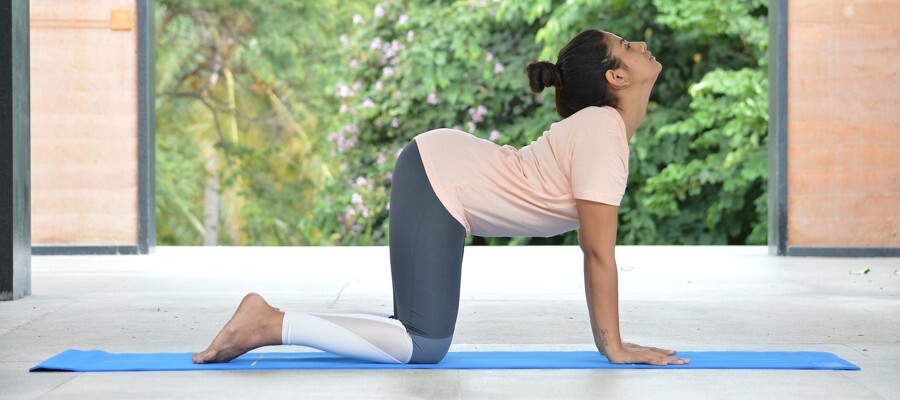
Read how to do Marjariasana.
Come onto your palms and knees, with your palms shoulder-width apart below your shoulders, and your knees hip-width apart below your hips. This is the starting position. Inhale while raising your head and gently arching the spine towards the floor. While exhaling, bring your chin towards your chest, and gently arch the spine upward. Repeat for 5-10 times. Be careful not to strain yourself.
Benefits
This position improves the flexibility of the neck, shoulders and spine, and tones the female reproductive system. Can be safely practiced during first 6 months of pregnancy.
5. Paschimottanasana
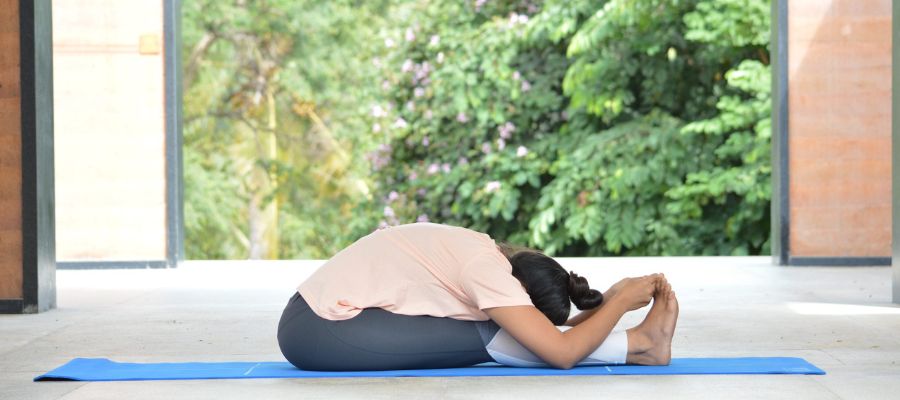
Sit tall with your legs stretched out and your toes flexed inwards. If necessary, separate the legs to to avoid any pressure on the belly. Inhale, and, raising both arms above your head, stretch up. Exhale, gently bending forward from the hip, but not fully. Keep your spine erect, moving toward the toes rather than toward the knees. Place your hands on your legs, wherever they reach. Stretch your arms out in front. Inhale, and come back up to the seated position. Exhale and lower arms.
Benefits
Stretches the lower back, massages the abdominal organs, and tones the shoulders.
more befits of Paschimottanasana.
6. Tadasana
Stand with your feet together and your arms at your side. As you inhale, raise your arms over your head, interlock your fingers, and then turn the palms upward. As you exhale, place your hands over your head. Inhale and stretch your arms, shoulders and chest upwards. Stretch your whole body from top to bottom. While exhaling, bring your hands on top of your head. Relax for few seconds, and repeat the whole round 5-10 times.
learn how to do Tadasana.
Benefits
Helps develop physical and mental balance.The entire spine is stretched and loosened, helping the back to stretch and relax.
7. Konasana 1 & 2
Breathe in, and raise your left arm. Breathing out, bend to the right, and look up at your left palm. Breathing in, come up. Breathing out, bring the left arm down. Repeat on the other side.
Breathing in, lift your arms overhead and join the palms together, interlacing your fingers to form a steeple position. Breathing out, bend to the right. Hold. Breathing in, return to standing position. Breathing out, bring your arms down. Repeat on the other side.
Benefits
Stretches the sides of body and spine, releasing tension and strain.
8. Trikonasana
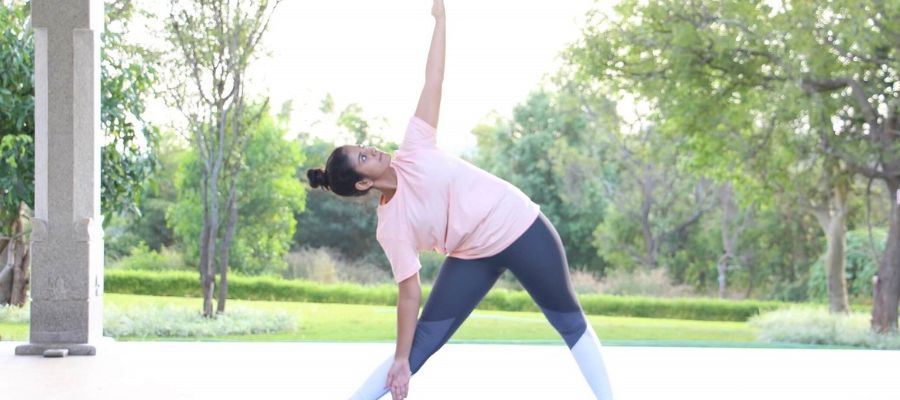
Stand with your feet apart, breathing in, and bring your arms parallel to the floor. Breathing out, extend and bend on your right side to bring the right hand closer to the right foot. Hold. Breathing in, slowly come up, and then relax. Repeat on the other side.
Benefits
Stimulates and improves blood circulation through the entire body, relieving aches and pains from back, legs and whole body.
more benefits of Trikonasana.
9. Virabhadrasana
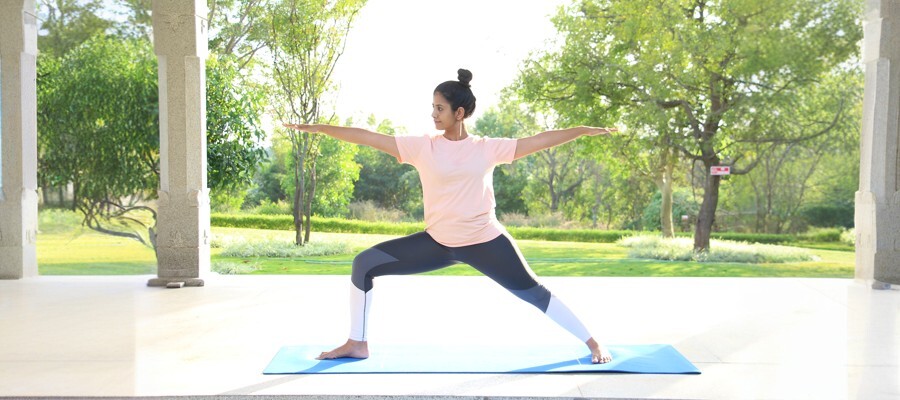
Stand with your feet 3-4 feet apart. Turn the right foot out by 90 degrees, and the left foot in by 15 degrees. Breathing in, lift your arms up to shoulder height. Exhale, and then bend your right knee, keeping it in line with the ankle, and a gently working to bring your right thigh parallel to the ground. Turn the head to the right, and look out across the right hand.
Hold the pose and breathe a few times. Inhale, straighten your right leg, exhale, and bring the arms down. Repeat on the other side. learn more about veerbhadrasana.
Benefits
Strengthens ankles, knees, shoulders, arms, legs, and back, and energizes whole body while also generating courage and self-confidence.
10. Utthanasan
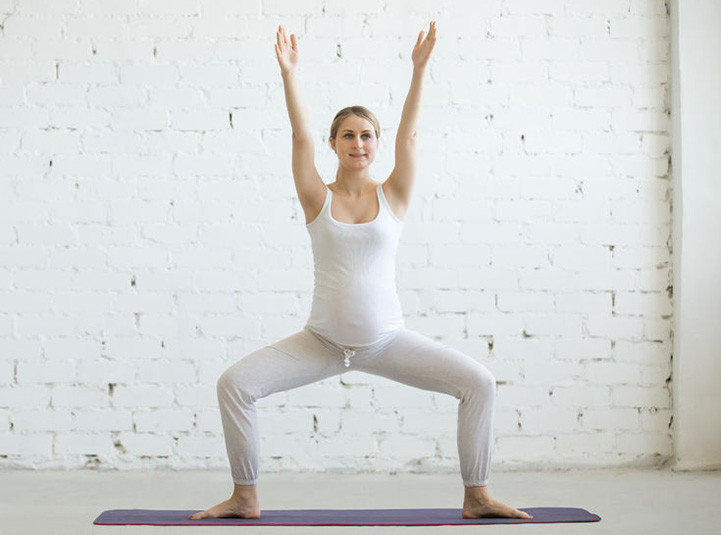
Stand erect on your feet about a meter apart, with your toes turned out. Interlock the fingers of both hands and let them hang loosely in front of the body. Slowly bend your knees and lower your buttocks. Straighten your knees and return to the upright position. Repeat this 7-10 times.
Benefits
Strengthens the muscles of the middle back, uterus, thighs, and ankles.
11. Setubandhasna
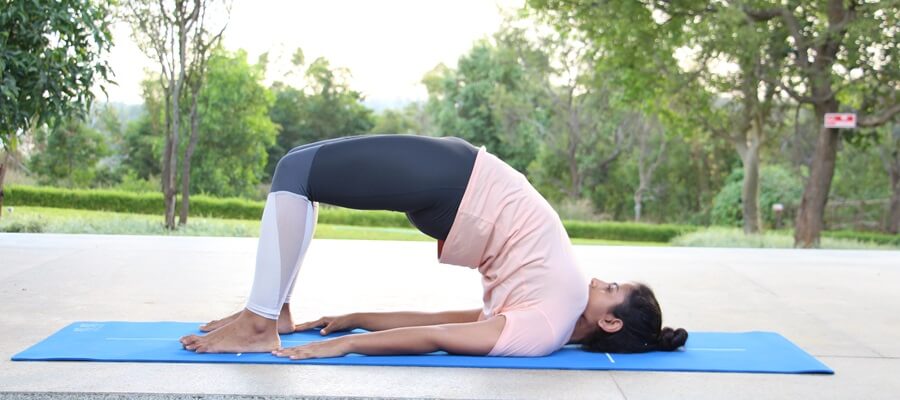
Lie on your back , and bend your knees. Knees and feet should be hip-width apart. Inhaling, raise the thighs, pelvis and gradually the whole back, bringing your chest to your chin. Stay there for a minute or so. As you exhale, slowly lower the back to the ground and relax.
Learn How to do Setu bandhasana.
Benefits
Realigns the spine and relieves backache. This position massages and stretches the colon and abdominal organs, improving digestion. Tones female reproductive organs and is especially recommended for women who tend to miscarry. Should not be done in advanced stages of pregnancy. Under expert guidance, this position has been successfully used to turn the baby when it is in a breech presentation.
12. Markatasana
Lie on your back. Interlock the fingers of both hands and place your hands beneath your head. Bend your knees, keeping the soles of your feet at the side edge of your mat. While breathing out, lower your knees halfway towards the the floor on right side. At the same time, move your head towards the left, giving a uniform, gentle, twisting stretch to the entire spine. While breathing in, bring the legs and head to the center. Repeat on the other side by bending your legs towards the left, and your head towards the right.
Benefits
Eases constipation, improves digestion. Relieves stiffness and strain in the spine caused by prolonged sitting or standing.
Relax with Savasana and yoga nidra, followed by pranayama and meditation.
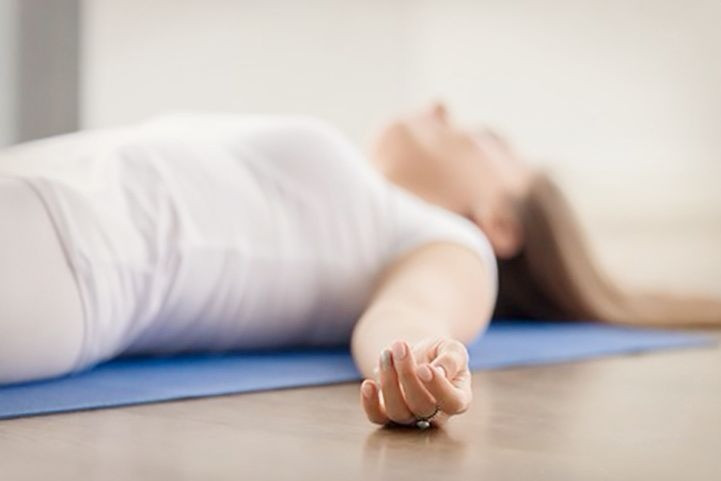
Breath work and relaxation are an essential part of pregnancy yoga, and can be a special time to connect with your baby. Find out here how to make them part of your daily routine.
Get a free Yoga Nidra MP3 to listen any time, any where!
Prepare well and stay happy! Take care of yourself! Only you know what feels right or wrong for you in any given moment. Follow your intuition, and pay careful attention to all of your needs. You will do great, Mama!
Yoga and Pregnancy
Pregnancy Yoga: Poses for Second Trimester and Third Trimester
This content is not intended to be a substitute for professional medical advice, diagnosis or treatment. Always seek the advice of your physician or another qualified health provider with any questions you may have regarding your pregnancy or associated a medical condition.

By Sejal Shah, E-YRT 500 Sri Sri Yoga Teacher, YACEP, Art of Living Teacher, Mind-Body Wellness Writer, Yogi, Meditator, Homeopath




